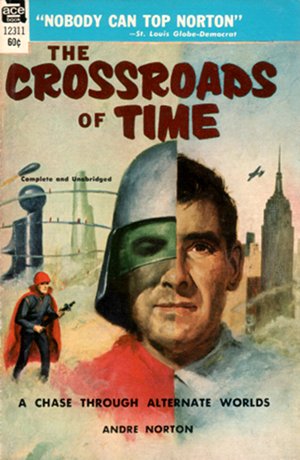The Crossroads of Time
by
Ace Books: New York, 1956
190 pages
Gregg Press: Boston, 1978
Across the time levels
 The Crossroads of Time by Andre Norton is one of her earliest science-fiction novels. It's a fine adventure across the spectrum of time levels, Norton's phrase for the alternate worlds created by branching history points and thence developing on parallel timelines.
The Crossroads of Time by Andre Norton is one of her earliest science-fiction novels. It's a fine adventure across the spectrum of time levels, Norton's phrase for the alternate worlds created by branching history points and thence developing on parallel timelines.
The protagonist, Blake Walker, is a young man thrust from our level into headlong chase and pursuit across the parallel worlds without much opportunity to absorb theory. So Norton does not develop her time-level background in anything like the detail of H. Beam Piper's Paratime series or Keith Laumer's later Imperium series.
The plot of The Crossroads of Time is perhaps inspired by some of the police procedurals among Piper's Paratime stories:
"There are points of departure even within the past few years," the man across the table was continuing. "Conceive a world in which Hitler won the Battle of Britain and overran England in 1941. Suppose a great leader is born too early or too late."
Blake's interest was sparked. ... "Napoleon born too soon."
"But suppose ... such a man, born out of his time in his own world, were given the ability to move from one possibility line to another — would he not be doubly dangerous? Suppose you were born in an era in which your own society stifled your particular talents, giving you, as you thought, no proper outlet."
"You'd then move to where you could use them."
Going forward and back along the SF-influence track, what seems closest in feel to The Crossroads of Time is Laumer's Imperium series; although standing at the head of all of this temporal parallelism is Murray Leinster's "Sidewise in Time" (1934).
Psionic powers of the major characters are not detailed as in Norton's own Star Rangers or elsewhere, although interesting and quite suspenseful as far as they go:
Vivid times that never were — hereThere was no click of the door, no movement within the office. Then he caught the faintest of scratching sounds as if someone were working at the lock. It lasted for only a moment. The stranger might be as intent on listening as Blake was.
But he was totally unprepared for what followed. Suddenly he was conscious of an intangible presence, a personality without body or substance. It was as if that other listener had projected an emanation of himself past the barrier he could not force. ...
The scenes we are given on several levels are quite vivid, and nicely integrated with the police procedural situation as well as with Blake's run-ins with the chief villain and his henchmen. Yet some of these alternate Earths are not merely like ours with edited history books: they are creepy-dangerous, or horror-dangerous, or even we might say nostalgic-dangerous. This is all uncharted territory for Blake, and he has no map:
If he could find a newspaper or its equivalent — some clue. Blake turned to the nearest shelves and picked up one of the containers, looking for a label. The pot was earthenware, beautifully molded, the cone top peaked into a knob. And the knob was a small head. Blake brought it into the light.
A head, right enough, but the head of nothing which had ever lived on any earth he could imagine — a hideous, grinning devil's head. Something like a gargoyle with a voodoo mask added.
More subtle stories about time or parallel timelines have been written; but not many with such compelling action or vividly sketched settings. The Crossroads of Time is exciting and memorable.
© 2007 Robert Wilfred Franson
Time at Troynovant
temporal philosophy and travel
Peace at Troynovant
happy interregnum betwixt war & war:
"peace in our time",
Occupation & Reconstruction,
Home Front, veterans
| Troynovant, or Renewing Troy: | New | Contents | |||
| recurrent inspiration | Recent Updates | |||
|
www.Troynovant.com |
||||
|
Reviews |
||||
| Personae | Strata | Topography |
|
|||